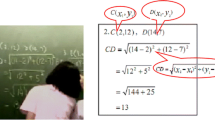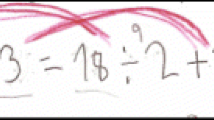Abstract
The purpose of this study was to investigate the affordances and constraints of a technological tool to foster pre-service teachers’ (PSTs) noticing skills including attending to, interpreting, and responding to students’ mathematical work. Participants were 99 junior or senior PSTs in a mathematics pedagogy course at a large university. Using LessonSketch, a web-based online platform, participants manipulated comics-based teaching scenarios to demonstrate what they attended to in a student’s mathematical written work and their related instructional decisions. Data comprised PSTs’ LessonSketch representations, their responses to prompts related to noticing skills, their reflections on the use of technology, and a focal group interview transcript. Inductive content analyses were applied to these data. The findings show that LessonSketch helped PSTs focus on how to ask questions, predict students’ answers, and respond in ways that supported students’ learning. The PSTs attended well to the student’s mistakes, but many did not clearly interpret her mathematical difficulties. Also, their pedagogical suggestions tended to be teacher-centered and procedural rather than supportive of conceptual learning. PSTs found LessonSketch helpful for locating themselves in the classroom situation and merging into the teaching moment. Despite the limitation of using only one written task, the study supports the critical role of technology in providing preliminary rehearsal of teaching practices and improving PSTs’ noticing skills, warranting further examination of the use of technology to support professional noticing.





Similar content being viewed by others
References
Amador, J., Weston, T., Estapa, A., Kosko, K., & de Araujo, Z. (2016). Animations as a transformational approximation of practice to communicate professional noticing. Journal of Technology and Teacher Education, 24(2), 127–151.
Baek, J. M., Wickstrom, M. H., Tobias, J. M., Miller, A. L., Safak, E., Wessman-Enzinger, N., et al. (2017). Preservice teachers’ pictorial strategies for a multistep multiplicative fraction problem. The Journal of Mathematical Behavior, 45, 1–14.
Bryman, A. (2012). Social research methods (4th ed.). New York: Oxford University Press.
Conner, A., & Gomez, C. N. (2019). Belief structure as explanation for resistance to change: The case of Robin. The Journal of Mathematical Behavior, 53, 196–209.
de Araujo, Z., Amador, J., Estapa, A., Weston, T., Aming-Attai, R., & Kosko, K. (2015). Animating preserivce teachers’ noticing. Mathematics Teacher Education and Development, 17(2), 25–44.
Fernandes, A. (2012). Mathematics preservice teachers learning about English language learners through task-based interviews and noticing. Mathematics Teacher Educator, 1(1), 10–22.
Ferrucci, B., Kaur, B., Carter, J., & Yeap, B. (2008). Using a model approach to enhance algebraic thinking in the elementary school mathematics classroom. In C. E. Greens & R. Rubenstein (Eds.), Algebra and algebraic thinking in school mathematics (pp. 195–209). Reston: NCTM.
Grbich, C. (2007). Qualitative data analysis: An introduction. London: SAGE Publications.
Herbst, P., Chazan, D., Chen, C., Chieu, V., & Weiss, M. (2011). Using comics-based representations of teaching and technology, to bring practice to teacher education courses. ZDM - The International Journal on Mathematics Education, 43, 91–103.
Herbst, P., Chieu, V., & Rougee, A. (2014). Approximating the practice of mathematics teaching: What learning can web-based, multimedia storyboarding software enable? Contemporary Issues in Technology and Teacher Education, 14, 356–383.
Jacobs, V. R., Lamb, L. L. C., & Philipp, R. A. (2010). Professional noticing of children's mathematical thinking. Journal for Research in Mathematics Education, 41(2), 169–202.
Lampert, M. (2010). Learning teaching in, from, and for practice: What do we mean? Journal of Teacher Education, 61(1–2), 21–34.
Leatham, K. R., Peterson, B. E., Stockero, S., & Van Zoest, L. R. (2015). Conceptualizing mathematically significant pedagogical opportunities build on student thinking. Journal for Research in Mathematics Education, 46(1), 88–124.
Lee, M. Y. (2018). Further investigation into the quality of teachers’ noticing expertise: A proposed framework for evaluating teachers’ models of students’ mathematical thinking. EURASIA Journal of Mathematics, Science, and Technology Education, 14(9), 1–15. https://doi.org/10.29333/ejmste/92019.
Lee, M. Y., & Choy, B. (2017). Mathematical teacher noticing: The key to learning from lesson study. In E. O. Schack, J. Wilhelm, & M. H. Fisher (Eds.), Teacher noticing: Bridging and broadening perspectives, contexts, and frameworks (pp. 121–140). New York: Springer.
Lee, M. Y., & Cross Francis, D. (2018). Investigating the relationship among elementary teachers’ perception about the use of students’ thinking, their professional noticing skills and their teaching practice. Journal of Mathematical Behavior, 51, 118–128. https://doi.org/10.1016/j.jmathb.2017.11.007.
Lee, M. Y., & Lim, W. (2020). Investigating patterns of pre-service teachers’ written feedback on procedure-based mathematics assessment items. International Electric Journal of Mathematics Education, 15(1), 1–12. https://doi.org/10.29333/iejme/5946.
Mason, J. (2002). Researching your own practice: The discipline of noticing. London: RoutledgeFalmer.
McDuffie, A. R., Foote, M. Q., Bolson, C., Turner, E. E., Aquirre, J. M., Bartell, T. G., et al. (2014). Using video analysis to support prospective K-8 teachers’ noticing of students’ multiple mathematical knowledge bases. Journal of Mathematics Teacher Education, 17, 245–270.
National Governors Association Center for Best Practices & Council of State School Officers [NGA & CSSO]. (2010). Common core state standards for mathematics. Washington, DC: National Governors Association Center for Best Practices & Council of State School Officers [NGA & CSSO].
Roller, S. A. (2016). What they notice in video: A study of prospective secondary mathematics teachers learning to teach. Journal of Mathematics Teacher Education, 19(5), 477–498.
Schack, E. O., Fisher, M. H., Thomas, J. N., Eisenhardt, S., Tassell, J., & Yoder, M. (2013). Prospective elementary school teachers’ professional noticing of children’s early numeracy. Journal of Mathematics Teacher Education, 16, 379–397.
Schack, E. O., Wilhelm, J., & Fisher, M. H. (2017). Teacher noticing and broadening perspectives, contexts, and frameworks. New York: Springer. https://doi.org/10.1007/978-3-319-46753-5.
Sherin, M. G., Jacobs, V. R., & Philipp, R. A. (2011). Situating the study of teacher noticing. In M. G. Sherin, V. R. Jacobs, & R. A. Philipp (Eds.), Mathematics teacher noticing: Seeing through teachers' eyes (pp. 1–13). New York: Routledge.
Sherin, M. G., & van Es, E. A. (2005). Using video to support teachers’ ability to notice classroom interactions. Journal of Technology and Teacher Education, 13, 475–491.
Sherin, M. G., & van Es, E. A. (2009). Effects of video club participation on teachers’ professional vision. Journal of Teacher Education, 60, 20–37.
Star, J. R., & Strickland, S. K. (2008). Learning to observe: Using video to improve preservice teachers’ ability to notice. Journal of Mathematics Teacher Education, 11, 107–125.
van Es, E. A. (2011). A framework for learning to notice students' thinking. In M. G. Sherin, V. R. Jacobs, & R. A. Philipp (Eds.), Mathematics teacher noticing: Seeing through teachers' eyes (pp. 134–151). New York: Routledge.
van Es, E. A., & Sherin, M. G. (2008). Mathematics teachers “learning to notice” in the context of a video club. Teaching and Teacher Education, 24, 244–276.
Walkoe, J., & Levin, D. M. (2018). Using technology in representing practice to support preservice teachers’ quality questioning: The roles of noticing in improving practice. Journal of Technology and Teacher Education, 26(1), 127–147.
Acknowledgements
The graphics used in these images are © 2017 The Regents of the University of Michigan, all right reserved. All graphics are used with permission, in compliance with terms of use.
Author information
Authors and Affiliations
Corresponding author
Additional information
Publisher's Note
Springer Nature remains neutral with regard to jurisdictional claims in published maps and institutional affiliations.
Rights and permissions
About this article
Cite this article
Lee, M.Y. Using a technology tool to help pre-service teachers notice students’ reasoning and errors on a mathematics problem. ZDM Mathematics Education 53, 135–149 (2021). https://doi.org/10.1007/s11858-020-01189-z
Accepted:
Published:
Issue Date:
DOI: https://doi.org/10.1007/s11858-020-01189-z




